
Page 35: of Maritime Reporter Magazine (February 2011)
Cruise & Passenger Vessel Annual
Read this page in Pdf, Flash or Html5 edition of February 2011 Maritime Reporter Magazine
February 2011 www.marinelink.com 35 "We had a good last year," notes Mikko
Niini, Managing Director at Aker Arctic
Technology, the Finnish marine engineer- ing company specialized in designing and developing ice-going vessels and offshore structures capable for operation in Arctic conditions. "Net sales were EUR6m. Aker
Arctic has grown into a company which employs 40 people," Niini notes. The company operates an ice model basin at its facilities in Helsinki, capable of simu- lating operations in all types of ice condi- tions, with test methods backed-up and confirmed by hundreds of real full-scale tests made over the years, many during the heydays of icebreaker construction at the nearby Helsinki shipyard. Since year 2005 Aker Arctic Technology has oper- ated as an independent company, sepa- rated from the yard, although STX
Finland, the Korean-owned Finnish ship- builder, still maintains a majority share- holding. Now Aker Arctic Technology again seems to be increasingly gaining work from the shipyard.
In recent years Aker Arctic took over some of the key staff from the shipyard in
Helsinki. The Helsinki yard saw its ship- building activities being transferred to the bigger Turku shipyard and has in recent years been primarily involved in ship re- furbishments and conversions and some small scale shipbuilding activities. Last year though STX Finland sold 50 percent of the yard to Russia's state-owned United
Shipbuilding Corporation USC. Now the activities at the Helsinki yard are being re- vitalized through this joint-venture, and an own design office and other vital func- tions at the yard, renamed Arctech
Helsinki Shipyard, are currently being es- tablished. As a vital part of this deal, USC also received an option to acquire a 20.4 percent shareholding in Aker Arctic Tech- nology, with shares sold by STX Finland, which still retains a 51% majority. The re- maining shares are still held by ABB and
Aker, each having 14.3% of the shares.
In connection with the new ownership arrangements, Sovcomflot placed a $200m order at the yard for two multi- functional icebreaking platform supply vessels. The delivery is set for spring 2013. These vessels of type Aker ARC 105 have been developed by Aker Arctic
Technology. The vessel type is further im- proved from the icebreaking supply and standby vessel Fesco Sakhalin, delivered by the yard in 2005. They continue the growing fleet of Aker Arctic's "double- acting" ships, which have proven very ef- ficient in breaking ice going backwards with the stern first, utilizing azimuthing thrusters to clean the ships path from the broken ice blocks. The 50 percent owner- ship in the Helsinki shipyard gives Sov- comflot and other Russian shipowners the possibility to order their Arctic ships from close-by Finland, where historically the main share of the Russian icebreaker and
Arctic cargo vessel fleets have been built, and where the Arctic know-how and tech- nology has been maintained and further developed over the years, very much thanks to the activities of Aker Arctic
Technology.
The vessel Fesco Sakhalin was built for serving a drilling platform operated by
Exxon Neftegaz in the Sakhalin area. Sov- comflot last summer bought this vessel from Far East Shipping Company. Sov- comflot has also expanded into operating supply vessels in the area, having recently also bought another vessel, the Pacific En- deavour, built in Norway. Exxon is build- ing a second offshore platform in the area,
Arkutun-Dagi, and Sovcomflot's two new- buildings will add the fleet which will serve the two platforms to three vessels.
A ship project currently being finalized by Aker Arctic Technology and the yard in Helsinki, together with Russian clients
Sovcomflot and Russian port organisation
Rosmorport, is the Oblique Oil spill and
Combat Icebreaker, another Aker Arctic invention. This vessel has an asymmetri- cal hull allowing the vessel to break ice and perform oil spill combat by proceed- ing sideways with the help of three az- imuthing thruster units. "This project would provide a nice continuation to those vessels now ordered," Niini notes.
Another major project based on Aker
Arctic's double-acting principle, and also detailed design services, were two 70.000dwt Arctic shuttle tanker new- buildings built by Admiralty Shipyards in
St. Petersburg, Russia. The project was concluded last year, with the delivery of
MT Kirill Lavrov. The first vessel,
Mikhail Ulyanov, was handed over to owner Sovcomflot a year earlier. The diesel-electric vessels, fitted with two
ABB's Azipod propulsion units, are in- tended to serve the Arctic oil production platform Prirazlomnoye, being built in
As the global maritime and offshore industries eye with great anticipation the business opportunities inherenent in an accessible Arctic Region, Henrik Segercrantz explores some of the challenges ahead.
Aker Arctic Technology operates an ice model test basin 75m (229ft) long and 8m (24.4ft) wide, where all existing ice conditions can be simulated. Model tests are a cost efficient method to design ships and structures for Arctic conditions.

 34
34

 36
36
